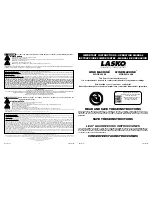
Making the Electrical
Connections
REMEMBER
to disconnect the power.
If you feel that you do not have enough
electrical
wiring
knowledge
or
experience, have your fan installed by a
licensed electrician.
Follow the steps below to connect the
fan to your household wiring. Use the
wire connecting nuts supplied with your
fan and supplied with remote control.
Secure the connectors with electrical
tape. Make sure there are no loose
strands or connections (Figure 13).
l.
Connect both green wires from the
down-rod and mounting plate to the
bare copper (Ground) from the electrical
box.
2. Connect the black wire (AC IN L)
from the receiver unit to the black wire
from the electrical box.
3. Connect the white wire (AC IN N)
from the receiver unit to the white wire
from the electrical box.
4. Connect the white wire (To Motor
N) from the receiver unit to the white
wire from the fan assembly.
5. Connect the black wire (To Motor
L) from the receiver to the black wire
from the fan assembly.
6. Connect the blue wire (For Light.)
from the receiver to the blue wire from
the fan.
After wires are connected, carefully
tuck them into the electrical box. Insert
the receiver unit into the mounting
plate; make sure the black antenna wire
sits on top of the receiver unit.
NOTE
THE FREQUENCIES ON YOUR RECEIVER
AND TRANSMITTER HAVE BEEN PRESET AT
THE FACTORY, BEFORE INSTALLING THE
RECEIVER, MAKE SURE THE DIP SWITCHES
ON THE RECEIVER AND TRANSMITTER ARE
SET TO THE SAME FREQUENCY. THE DIP
SWITCHES ON THE TRANSMITTER ARE
LOCATED
INSIDE
THE
BATTERY
COMPARTMENT.
WARNING
EACH WIRE NUT (WIRE CONNECTOR)
SUPPLIED WITH THIS FAN IS DESIGNED TO
ACCEPT UP TO ONE 12 GAUGE HOUSE WIRE
AND TWO WIRES FROM THE FAN. IF YOU
HAVE LARGER THAN 12 GAUGE HOUSE
WIRING OR MORE THAN ONE HOUSE WIRE
TO CONNECT TO THE FAN WIRING,
CONSULT AN ELECTRICIAN FOR THE
PROPER SIZE WIRE NUTS TO USE.
7.











































